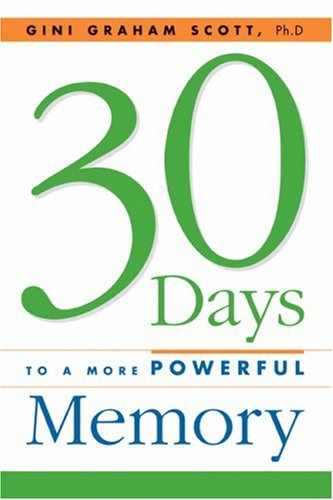Book Description
With phones ringing off the hook, constantly changing to-do lists, and increasingly complicated schedules, having a good memory has become more important than ever. Drawing on the latest research from cognitive experts and psychologists, 30 Days to a More Powerful Memory provides hands-on, practical strategies and exercises that anyone, young or old, can use to sharpen their memory -- fast! The book introduces readers to memory-boosting techniques such as mnemonic devices, visualization, chunking and clustering, and mental triggers, and also shows how to: * effectively decrease anxiety levels and combat the negative emotions that can affect recall * create powerful backup systems to help trigger associations * exercise both body and mind, and improve overall health to improve memory * get the kind of restful sleep that will increase one's ability to retain information. The book discusses common myths about memory, clarifying what's true and what isn't. Packed with tips and memory-boosting activities, this guide provides readers with the simple but powerful methods they need to increase their mental agility. AUTHORBIO: Gini Graham Scott, Ph.D. (Oakland, CA) is the founder and director of Changemakers and Creative Communications & Research. She is the author of over 40 books, including A Survival Guide for Working with Bad Bosses (0-8144-7298-2), and A Survival Guide to Working with Humans (0-8144-7205-2). Frequently sought out by the media, she has been interviewed for Good Morning America, Oprah, Geraldo at Large, Montel Williams, The O'Reilly Factor, The New York Times, Glamour, and Cosmopolitan.
Table of Contents
- Copyright
- Introduction
- 1. How Your Memory Works
- 2. How Your Long-Term Memory Works
- 3. How Good Is Your Memory?
- 4. Creating a Memory Journal
- 5. Pay Attention!!!
- Learning to Pay Attention
- Creating a Memory Trigger to Increase Your Ability to Focus
- Using a Physical Trigger or Motion to Keep Your Attention Focused
- Using Clear Memory Pictures or Recordings to Improve Your Memory
- Looking at Things More Accurately
- Listening to What You Hear
- Seeing Like a Camera; Listening Like a Cassette Recorder
- Experiencing an Object
- More Tips for Paying Attention
- Prepare Yourself to Pay Attention
- Learning to Pay Attention
- 6. Improving Your Health and Your Memory
- 7. Decrease Stress and Anxiety to Remember More
- 8. Increase Your Energy to Boost Your Memory Power
- 9. It’s All About Me!
- 10. Remembering More by Remembering Less
- Creating a Passwords File
- Creating a File for Lock Combinations
- Using a Keyword Reminder
- Creating a Tickler File
- Using a Daily Calendar
- Putting Things in Their Place
- Placing Reminders Along the Way
- Putting Out What You Need the Night Before
- Creating a To-Do List or Checklist
- Keeping Track of Cards You Collect
- Using a Reminder Service
- Arranging for Reminders from Other People
- Setting Up an Alarm
- Putting Up a Reminder Bulletin Board
- Carrying a Notebook or Notepad with You
- Doing Something in Advance So You Don’t Have to Remember to Do It Later
- Creating an Appointments Scheduler and Results Form
- Creating a Follow-Up Matrix
- Using Post-its or Cards with Reminders
- Creating Your Own System
- Reviewing Your Reminders
- 11. Using Schemas and Scripts to Help You Remember
- 12. Chunk It and Categorize It
- 13. Rehearse . . . Rehearse . . . Rehearse . . . and Review
- 14. Repeat It!
- 15. Talk About It
- 16. Tell Yourself a Story
- 17. Remembering a Story
- 18. Back to Basics
- 19. Take a Letter
- 20. Linked In and Linked Up
- 21. Find a Substitute
- 22. It’s All About Location
- 23. Be a Recorder
- 24. Record and Replay
- 25. Body Language
- 26. Let Your Intuition Do the Walking
- 27. Remembering Names and Faces
- 28. Remembering Important Numbers
- 29. Walk the Talk: Speeches, Presentations, and Meetings
- Don’t Try to Memorize It All
- Create an Outline or Mind Map with Key Words or Trigger Words
- Use a Visual, Peg, or Link System to Help You Remember the Trigger Word
- Decide Which System to Use to Help You Remember Your Speech or Presentation
- Use Rehearsal and Repetition to Put Your Trigger Words into Long-Term Memory
- Using a Relaxation Technique to Overcome Anxiety
- Notes
- Resources and References
- About the Author
